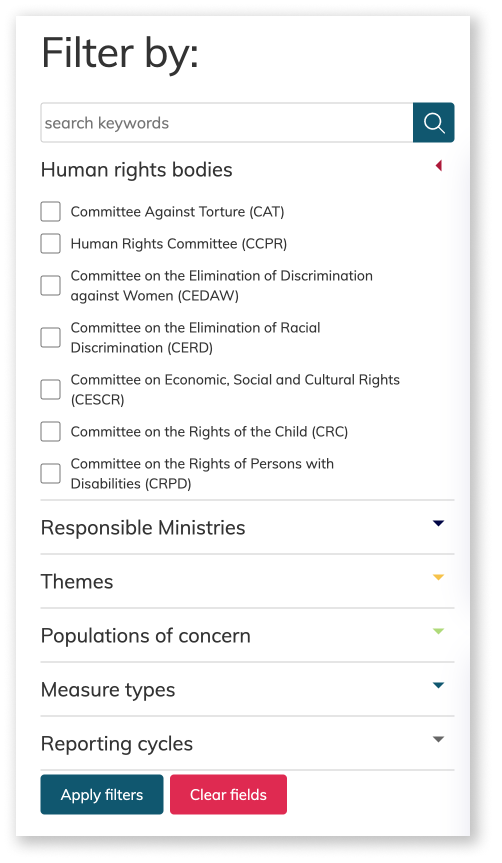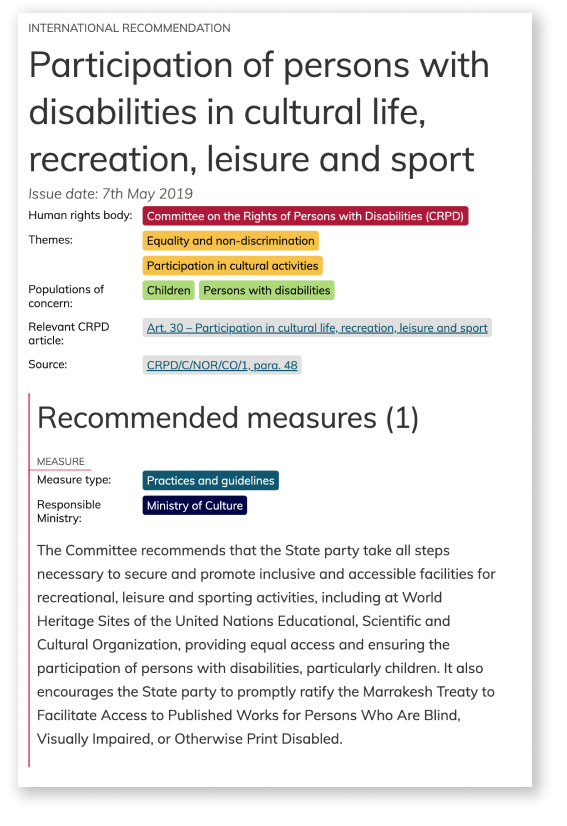The tracker is a searchable online tool developed by the Norwegian National Human Rights Institution (NIM) to track international human rights recommendations to Norway.
The tracker contains all of the recommendations made by United Nations Treaty Bodies to Norway since 2017 and will be updated accordingly as new recommendations are made. Recommendations from selected human rights treaty bodies within the Council of Europe will be added at a later stage.
We hope the tracker will be a useful monitoring tool for the Government, civil society, ombud institutions, academics and the international bodies themselves, supporting efforts by all to protect and promote human rights in Norway.
How to use the tracker
The tracker allows you to filter the recommendations according to human rights bodies, responsible ministries, themes, populations of concern, measure types and reporting periods. There is also a free-text option that allows you to search the recommendations for keywords.

- Human rights bodies refer to the expert bodies established by the United Nations and the Council of Europe to monitor the implementation of human rights treaties that have been ratified by Norway. You can at this stage choose from eight UN Treaty Bodies – CAT, CCPR, CED, CEDAW, CERD, CESCR, CRC and CRPD.
- Responsible ministries refer to the government ministries which NIM has been informed are responsible for following up on particular recommendations. Where a recommendation has not been allocated to a particular ministry, this is marked as “unknown ministry”.
- Themes refer to the common human rights issues or challenges that NIM has identified in the recommendations, such as education, health or privacy. Some themes, such as “justice, liberty and personal security” have sub-categories, such as “isolation, policing and prisons”.
- Populations of concern refer to the groups or minorities that are the subject of the recommendations. Some populations of concern, such as “National minorities” have sub-categories.
- Measure types refer to the types of government actions recommended by the human rights bodies, such as “awareness raising, laws and regulations, policies, strategies, and action plans, and practices and guidelines”.
- Reporting cycles refer to time periods in which Norway has been examined by all of the human rights bodies. These are defined by NIM as a way of grouping each round of international reporting and do not correlate with the cycles used by the bodies themselves. The most recent reporting cycle in which Norway was reviewed by all United Nations Treaty Bodies was 2017-2020. The next cycle will most likely be 2022-2025.
Once you have applied your search filters, you will see a preview of the relevant recommendations. Click on the title of a recommendation to view the recommended measures in full. On the recommendation page you will also find a link to any relevant treaty articles and a link to the original source document, which often includes additional background information.

The legal status of international recommendations
The recommendations of international human rights bodies are not legally binding. According to the preparatory works for the Norwegian Human Rights Act (1999), the recommendations of United Nations Treaty Bodies shall be given “significant weight” when viewed purely in the context of international law, while their importance in individual cases in Norway “may vary depending on how clear the recommendation is and to what extent a given case is similar to the situation the Committee was probably envisaging when writing the recommendation”.
Given that international human rights bodies are comprised of independent experts in their field, their assessments may also carry considerable weight as authoritative interpretations of international law or best practice in the area.
More information about the human rights framework in Norway is available here.
Changelog
- 29.02.2024 – Updated with responsible ministries for the CRC recommendations from 2018.
- 12.06.2023 – Updated database with 27 recommendations from CEDAW. New reporting cycle added: “2022-“.
- 12.01.2023 – Published the database with 155 recommendations from 2017–2020.